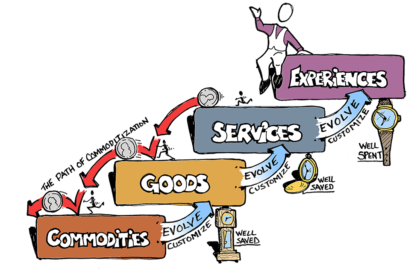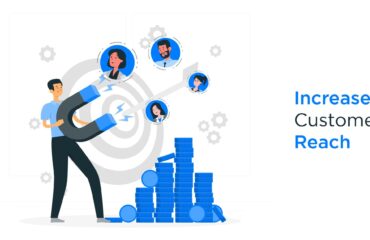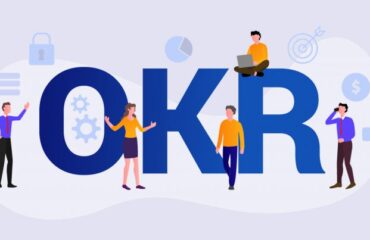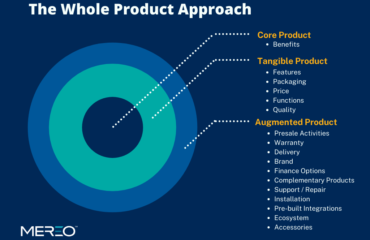
Experiences they say last a lifetime …But how do you package the experience to make it last a lifetime? Let’s start with a small everyday example
Imagine this: I’m looking to buy a dessert (and sweets are my all time favorite) and I find myself standing in front of two bakeries both of which sell quality products.
The first bakery is a plain store with the sweet flavor that I like lined up behind a small shelf. Its prices are the cheapest on the street. Customers line up, pay for their sweet and leave.
The second bakery is much more expensive. It’s decorated in colorful hues. Music is playing and small tables are set up around the room in case you want to enjoy the ice cream right there. There’s even a hashtag on the wall, in case you want to share a photo of your sweet purchase with the world.
Which would you pick?
You might immediately say, “the first one, of course!” After all, it tastes as good as the sweet in the second store and it’s cheaper. But research shows that more people will, in fact, pick the second store.
That’s what experience does to differentiate…
But what prompted me to write this article was an experience which was shared by my ex-engineering roommate, now a very successful and innovative jewelry chain owner who has a knack of turning everything he touches into gold. He shared an experience he had while holidaying with family .He was checking into one of India’s popular 5 star hotel chains and he was taken aback when he was received at the reception by the owner of the hotel chain itself who personally got him through the check in formalities including an upgrade and made him and his family feel completely at home.
He also recounted the numerous times he has gone back to the said chain just because of that single personalized experience …. For someone who travels the world and stays in the best of places remembering that one experience after so many years made me realize the lasting memory a good experience makes on anyone…
So… what is an experience economy?
The term “Experience Economy” was actually coined 20 years ago by James H. Gilmore and B. Joseph Pine II. In their book of the same name, they explained that customers are seeking experiences above and beyond products and services, that services need to be mass-customized for each individual need, and that offerings need to charge for time (subscriptions).
They also pointed out that more companies should pay attention not just to what employees should do, but how they do it.
The experience economy that Gilmore and Pine described surrounds us today; we live in an experience economy. Further accelerated through digital transformation, we subscribe to video on demand platforms, we have highly personalized online experiences, and we are willing to pay more for faster delivery and better service.
Thus, it is not surprising that customer experience has become the new dividing line between winners and losers in the market. Winners know their customers and have built a trusted relationship with them. Incumbents as well as start-ups are racing to compete on engaging customer experiences.
So, what do companies need to do to compete in the experience economy?
1. Make customer experience everyone’s responsibility
Malcolm Gladwell remarked in one of his talks at the 92nd Street Y in New York that in large organizations “people, over time, put the needs and desires of those inside the organization ahead of he needs and desires of the ones they are serving”. I fully agree with him.
In most organizations people tend to work in silos catering to just their department targets which are very often far away from taking care of customer requirements which is for what everyone in the company is there for
Getting rid of these and making everyone responsible for building the experience is the first starting block.
2. Personalization…personalization…. personalization
The key goal in all experiences is to build personalization
Am sure we have all come across replies that we get from customer care email address of many companies …Mostly the replies that we get are very standard without even an attempt being made to understand the issue being raised by the customer
3. Make the customer facing employee as the top of the pyramid
It is clear that the experience of the customer-facing workforce in serving customers is tremendously important. Several companies have introduced the model of the reversed pyramid where every customer-facing employee is at the top of the pyramid and the CEO is at the bottom. One of the reasons for this model is that these companies want to ensure that their employees are trained well and have the tools to deliver remarkable experiences to their customers.
4. Seamless hand-holding between back office and the front end
With better connectivity the back-end of most companies is centralized or in several cases outsourced to others. This results in the back office working on just their key KPIs and the front end on their KPIs very often forgetting that the very purpose of creating a full-fledged back end is to enrich the customer experience…Building seamless hand holding between the two is one of the most key factors in today’s connected world.
5. Utilizing technology to enable experiences and not to control
The CRM packages and tools that have come about in the last 20 years have dramatically made tracking of customers much easier and at the touch of a button. In the earlier manual system, the manual reports were mandated to keep a track on things and control things better so that customer issues etc were not lost out. I remember the huge cumbersome manual customer complaint tracking mechanisms we had when I started out my carrier. Several of the CRM packages just coded these processes without trying to empower and help the team in the changed scenario. So, all the control fields and data points which were essential in a manual system just got coded without really helping out to improve the experiences and so several of these packages just keep asking for data and more data from customer facing employees
So, these CRM solutions just ask for more and more data without really thinking of ways to how the collected data can be used to better personalize the customer experience.
6. Utilizing new age tracking tools for actually bettering customer experience
The data points of the customer that are already there with companies sometimes captured over years can really help to predict customer actions and enable the customer facing staff to do things to build the customer experiences
While some online companies are started doing this this is a key area which will dramatically alter personalized experiences.
And with technologies like AI this is something which can easily be done. Through artificial intelligence (AI) and smarter solutions, we now see a significant shift to solutions that prescribe the next best action, and are actually helpful to the customer-facing workforce and reduce the administrative burden and helping employees build trusted customer relationships
7. Data points at every point to enrich the experience
Having experience data from customers in real-time connected into your organization is the most crucial differentiation in the connected world. Connecting this experience data and bringing it into your internal operations will not only improve the services provided but will also make everyone in a company focus on a more customer-centric model.
To build the experience companies will have to make sure to measure everything. Just like the financial economy is charted, analyzed, and measured at every level – the experience economy needs to be backed by data. A recipe for success: Know who your super-fans are before they arrive, build long-term relationships with them by striking an emotional chord, and quantify (then optimize) how your marketing activations impact them.
8. Creating the selfie moment that then go viral on social media
Creating brand experiences is one thing but constructing these experiences to be truly picturesque and video-worthy is where the winner takes all in the attention battles. In our mobile-first world, a photo can be enhanced within minutes of an experience unfolding and then can be shared and re-shared via a social network.
9. FOMO
FOMO (fear of missing out) is described in the Oxford dictionary as anxiety, often brought upon by posts seen on social media, that some exciting event may be taking place elsewhere. Recent research found that nearly 7 out of 10 millennials experience FOMO and it is driving “millennials’ experiential appetite”. Decisions, whether conscious or subconscious, are often motivated by social pressure, exclusivity, and limited-time opportunities. Brands that are building experiences that are “FOMO-worthy” are cashing in as their customers share experiences with all their followers.
10. Respect privacy
The amount of personal information that employees get access to because of the building of the experience economy is immense…Companies will have to ensure that employees learn to respect privacy of the data available and learn to use the same effectively.
While examples of implementing these are many let me just quote an example of an old bookstore which has adapted the experience economy effectively.
The Last Bookstore in Los Angeles, which has turned book shopping into an experience. The entire store is a bibliophile’s fantasy, with book tunnels and book displays suspended from the ceilings.
The store also has spaces for book or theater events and even a gallery for an arts collective. Not surprisingly, the store is incredibly popular, and despite the dozens of independent bookstore closures in the US, it’s had to expand its space since opening.
The change in consumer spending preferences has created the perfect environment for brands to create super-fans and ambassadors via the experience economy.
Consumers are actively seeking out the amazing experiences that brands can offer. However, creating super-fans goes beyond having Instagrammable events with free drinks and colorful photo booths. The secret sauce in creating super fans through experiences isn’t just about knowing how to produce “fun” events – but rather being able to connect with attendees on an emotional level and engage people to bring real value to them
Millennials have gained a reputation for their tendency to prioritize experiences over products. A study by Harris Group found that 72 percent of millennials would rather open their wallets based on experiences rather than on material items.
So, for all companies to survive and grow they not only have to create better goods and services but also focus on delivering a compelling and consistent customer experience. If you deliver a great experience, they will come back! If you don’t, they’ll go elsewhere. Welcome to the experience economy.
My discussion with my jeweler friend Rajiv (Chungath Jewellery) was how to bring the personalized customer experience to commodity product like gold and into his chain of gold stores and with his forward-looking thinking am sure he will find a way to create a truly memorable experience that will make him scale greater heights.
It is this realization among traditional businessmen and entrepreneurs like him that will help us to live the experience economy better.



